
There was a time when eating specialty mushrooms was reserved for those looking for a mind-expanding experience or with sufficient income to frequent five-star restaurants. How times have changed. Over the past 10 years, specialty mushrooms (not the hallucinogenic types) have become the rage, with more kinds popping up in grocery stores and natural food markets. The ubiquitous white button mushroom is still tops in popularity, but interest in other kinds such as oyster, portabello, and shiitake is increasing. Not only do these specialty mushrooms have full-bodied and unique flavors, but some, such as shiitake, are being touted for their health benefits.
The only downside is the price. Some fresh mushrooms can cost $10 or more per pound at the market, making them no more than an occasional dinnertime indulgence. But if you get hooked on the flavor of these gourmet treats, you have a few options. You can win the lottery and buy all the mushrooms your heart desires -- a nice thought, but not too likely. You can learn how to forage in the wild for some of these naturally occurring fruits, but, of course, risk a potentially deadly misidentification.
A better option is to grow your own. Commercial growers have responded to consumers' love of fresh gourmet mushrooms by introducing kits that produce gourmet mushrooms in no time. Although you won't get an unlimited supply, in a few weeks you'll be eating fresh homegrown mushrooms.
Experimenting with these kits ($20 to $30) is a good way to find out if you want to dive deeper into mushroom growing. If you do get hooked on gourmet mushrooms, you can move on to the next stage: inoculating logs with mushroom spores to gain years of continuous supply growing in your basement or backyard.
Mushrooms 101
Although mushrooms are fungi, the edible part is considered a fruiting body. Mushrooms reproduce by spores, which germinate into white masses called mycelia. To grow, mushrooms need a clean food source such as compost, sawdust, straw, or wood that is free from competing microorganisms. Commercial growers inoculate their medium with pure mycelia grown on spawn (mushroom growers' equivalent of a mushroom seed). The mycelia require temperatures of 70oF to 80oF, a moist medium, and high humidity. Once the mycelia have spread throughout the medium, fruiting will begin as small protrusions called pins. Within a few days, the pins mature into the species of mushroom you're growing. Mushrooms need to be checked daily at this point, since the best flavor and texture are found when the mushroom caps are open, but not fully unfurled and flat.
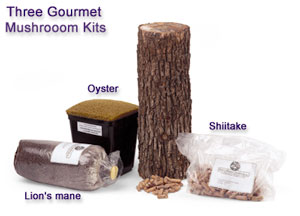
Choose Your Fungus
The most widely available and easiest-to-grow mushrooms include white button, crimini, portabello, lion's mane, shiitake, and oyster. The simplest kits consist of a bag of sawdust or grain straw already inoculated with spawn. Kits come with full instructions, and for most all you need to do is open the bag, keep it at room temperature in a bright place but out of direct sunlight, and mist daily to keep humidity high. Some kits even provide plastic tents for humidity control.
Most kits start fruiting within 7 to 10 days. You can expect to harvest a total of 1 to 2 pounds of mushrooms from two or three flushes of growth over one to three months. You can store most kinds of harvested mushrooms in paper bags in the refrigerator for five to seven days. When fruiting is finished and it's springtime, bury the kit in bark mulch or your compost pile, and fruiting may continue as weather permits.
Here are brief descriptions of the most popular types of mushrooms you can grow at home.
White button, crimini, and portabello (Agaricus bisporus). These mushrooms are strains of the same species. One- to two-inch-wide white buttons are the most popular and widely available mushrooms worldwide. Crimini, a brown button mushroom strain, are similar except for the color and a more pronounced flavor. The most impressive of this group are portabellos, which produce 6-inch-diameter or larger brown caps with a tender, meatlike texture and woodsy flavor. Portabello mushrooms keep somewhat longer than other mushrooms: 7 to 10 days. Growing these mushrooms requires a few extra steps including mixing the spawn with compost in a cardboard box and waiting one to three weeks for the mycelia to run before mushrooms begin to form. Although this type of kit is more work, yields are higher: 3 to 6 pounds in three or four flushes of growth over three months.
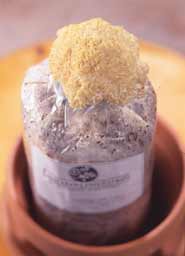
Lion's mane (Hericium erinaceus). These pure white mushrooms consist of multiple strands clumped in a round form, sometimes 6 or more inches in diameter. They have a firm texture and a flavor similar to that of crab or lobster. Growth is a little slower, and fruiting is best at room temperature.
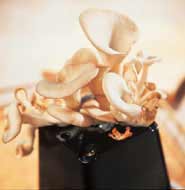
Shiitake (Lentinula edodes). Thick, meaty-textured shiitakes are considered "king of the mushrooms." These 3- to 4-inch-diameter brown mushrooms with white flecks are highly esteemed fresh and dried for cooking and for their medicinal properties. Researchers have found that they reduce blood pressure, lower cholesterol levels, stimulate the immune system, and have anti-tumor properties; they are also being used in AIDS research. Kits fruit easily indoors over a wide temperature range (55° F to 75° F), producing 2 to 3 pounds of fruits total over two to three months at two-week intervals. They store for up to 14 days.
Oyster (Pleurotus). These popular mushrooms are so named because their taste and texture somewhat resemble oysters. All kinds like high humidity and need to be misted two or three times a day for best fruiting. The blue dolphin (P. ostreatus) has a distinctive pewter coloring and fruits best below 65° F. Golden oyster (P. cornucopiae) has luminous yellow fruits that are most intensely colored when grown in bright light. The fedora or white oyster (P. ostreatus) is the easiest and fastest of all oysters to grow, fruiting over a wide temperature range (55° F to 75° F) and producing mild-flavored white fruits.
More Mushrooms by the Log
Even though kits are the simplest way to produce gourmet mushrooms, the small harvest they produce may only whet your appetite. A more economical method is to buy spawn and inoculate hardwood logs yourself. Many gourmet mushrooms (including all mentioned above except button, crimini, and portabello) can be grown this way.
Compared to sawdust- or straw-based kits, logs provide more food for mushroom growth, producing a higher yield of mushrooms over a longer period more economically. For example, a ready-to-fruit kit costs about $20 to $30 and produces 1 to 2 pounds of mushrooms in one to two months. That's about $15 per pound. A $20 log-based kit inoculates about five logs. Although you'll need to wait 9 to 12 months for the first fruits to form, fruiting will continue periodically over four years, eventually producing about 20 pounds of mushrooms total. That's about $1 per pound. If you can't wait, some mail-order companies provide preinoculated logs with the mycelia already running throughout the log. Though more expensive than producing your own (about $38 per log with kit and soaking tray), these will usually produce mushrooms within a week of arrival, yielding 4 pounds over three to four years.
Growing your own mushrooms from logs takes more time, materials, and care than using the ready-to-fruit kits. Shiitakes, which are among the most popular log-growing mushrooms, require that you cut logs of the right type and age, inoculate them with plugs of spawn, and keep them at the correct humidity and temperature for fruiting. Follow these steps for growing mushrooms on a log.
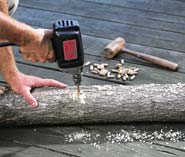
Indoor Shiitake Step-by-Step
1. Use nonaromatic hardwoods such as alder, oak, sugar maple, or sweet gum. Cut 3- to 6-inch-diameter logs into 3- to 4-foot lengths one to three months before inoculating in spring. Spring-inoculated logs will probably fruit in fall in southern areas and in the following summer in northern area. Drill 5/16-inch-diameter, 1-1/2-inch-deep holes 4 to 6 inches apart within the row and 1-1/2 inches between rows all around the log.
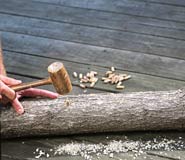
2. Inoculate your logs with a plug kit -- spawn formed into small plugs you pound into holes. A kit with 300 plugs costs about $20, enough for six logs. Gently tap a plug into each hole with a hammer or mallet.
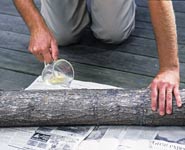
3. Seal the plugs with melted beeswax or cheese wax to retain moisture. Stack the inoculated logs perpendicular to each other in a shady, moist, sheltered location. Under an evergreen tree on the north side of the house is ideal. Water periodically to keep the logs moist, but allow them to dry out between waterings. After 9 to 12 months, you should notice irregular circles of white growth on the cut ends of the logs. This means fruiting is imminent. You can let nature take its course and allow the mushrooms to fruit when weather conditions are favorable, or you can force them by soaking the logs overnight in barrels of cold water. This shock will start the fruiting process. After fruiting finishes, let the logs rest for six to eight weeks before repeating the cold water immersion.
Charlie Nardozzi is a senior horticulturist at National Gardening.
Photography by Bill Lorenz
 Charlie Nardozzi is an award winning, nationally recognized garden writer, speaker, radio, and television personality. He has worked for more than 30 years bringing expert gardening information to home gardeners through radio, television, talks, tours, on-line, and the printed page. Charlie delights in making gardening information simple, easy, fun and accessible to everyone. He's the author of 6 books, has three radio shows in New England and a TV show. He leads Garden Tours around the world and consults with organizations and companies about gardening programs. See more about him at Gardening With Charlie.
Charlie Nardozzi is an award winning, nationally recognized garden writer, speaker, radio, and television personality. He has worked for more than 30 years bringing expert gardening information to home gardeners through radio, television, talks, tours, on-line, and the printed page. Charlie delights in making gardening information simple, easy, fun and accessible to everyone. He's the author of 6 books, has three radio shows in New England and a TV show. He leads Garden Tours around the world and consults with organizations and companies about gardening programs. See more about him at Gardening With Charlie.
 Victory Seed Company has all the seeds you want for your best garden in 2024.
Victory Seed Company has all the seeds you want for your best garden in 2024.
For 25 years, the family-owned Victory Seed Company has provided the highest quality vegetable, herb and flower seeds to families across the country. We are passionate about providing you the best seeds available that give excellent germination, robust plants, and the harvest you want. With a catalog of over a thousand varieties, we have everything, and our prices are the kinds that we'd want to pay. We have hundreds of yesterday's heirloom vegetables, as well as today's award winning hybrid selections. Get to know us by visiting our website and browsing through our online vegetable seed catalog.